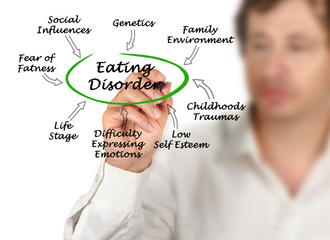Written By: Bridget Shertzer, LPC
Site Director at The Renfrew Center of Philadelphia – Center City
As a clinician working with eating disorders, it is common to hear; “it started in middle school” or “my first diet was when I was 13.” What is it about adolescence that can make us so vulnerable to the emergence of an eating disorder? The answer is complex and often a combination of genetic and environmental factors. We’ll explore some of those factors in this post and discuss what can be done to help a struggling teen on their road to eating disorder recovery.
Eating Disorders & Adolescence
 Anyone who works with teens or even has a teenager who they’re close to, knows that it’s a very vulnerable time. From just a biological standpoint, teens are going through a lot of changes. Puberty is a critical time for brain and body development, and sometimes that can result in teens feeling confused, isolated, and out of control of the changes occurring internally and externally. Teens are both trying to exert independence and autonomy while simultaneously attempting to find their place in their world and social circles. With so many external influences telling teens who they should be and what they should look like, it’s no wonder they start to feel out of control and instead try to find something to help mitigate that distress.
Anyone who works with teens or even has a teenager who they’re close to, knows that it’s a very vulnerable time. From just a biological standpoint, teens are going through a lot of changes. Puberty is a critical time for brain and body development, and sometimes that can result in teens feeling confused, isolated, and out of control of the changes occurring internally and externally. Teens are both trying to exert independence and autonomy while simultaneously attempting to find their place in their world and social circles. With so many external influences telling teens who they should be and what they should look like, it’s no wonder they start to feel out of control and instead try to find something to help mitigate that distress.
Why Do Eating Disorders Form & Thrive in Teens?
Eating disorders are commonly thought to be about food and body image, and for some that may be true. However, research shows that eating disorder behaviors stem from a lack of emotional regulation skills and teens can especially struggle to manage emotions. In short, eating disorders can be coping mechanisms, but they’re unsustainable.
When someone feels uncomfortable emotions, they often try to do something to help decrease or end that emotion. Adolescence is a time when teens are trying all sorts of new things, including how to navigate and tolerate their own emotional experiences. If restricting, binging, purging, or excessive exercise helps them feel “better” in the short term, they learn that those behaviors help an uncomfortable emotion go away. But in the long term, they don’t develop the skills needed to help regulate and tolerate that emotion. Eating disorder behaviors are then maintained by this cycle of short-term gratification.
Essentially, teens learn over time that emotions are “dangerous” and cannot be tolerated, when in fact the behaviors we sometimes use to end the emotion is what can actually be dangerous. Not the emotion itself.
Types of Eating Disorders to Look Out for in Teens
Teens can and do develop all kinds of eating disorders, but some are more common than others. Let’s look at the types loved ones should be most sensitive to and aware of.
Anorexia
Anorexia nervosa is one of the most common types of eating disorders to develop in adolescence. Anorexia is a restrictive eating disorder, meaning it is characterized by avoidance of certain foods and the formulation of rigid foods “rules.” People who struggle with anorexia can be perfectionistic in nature and will often be preoccupied with their body shape and size. Anorexia can result in sometimes severe medical concerns, such as cardiac issues.
Bulimia
Bulimia nervosa is another commonly known eating disorder, which is characterized by a period of eating a large amount of food followed by a compensatory behavior, such as self-induced vomiting or intense exercise, to “make up” for the consumption of food. Those who struggle with bulimia often report feeling “out of control” around food and will frequently eat past the point of satisfaction. Like anorexia, there is typically also the presence of body image distress.
Binge Eating Disorder
Binge eating disorder, like bulimia, can be characterized by periods of eating beyond satisfaction, but is absent of a compensatory behavior following. People who struggle with binge eating disorder will often eat in isolation or hide evidence of their binges. This causes significant distress surrounding the act of eating and can also result in feelings of being “out of control.”
ARFID
Avoidant restrictive food intake disorder, or ARFID for short, is one of the newer types of eating disorders that we’ve seen emerge over the past few years and is very common in adolescence. Previously, ARFID was seen as mostly present in neurodivergent folks, or individuals on the autism spectrum, but that is no longer the case. Typically seen as “picky eating,” ARFID is characterized as the avoidance of certain foods based on texture, fear of vomiting or choking, and a total disinterest in food or eating. What sets it apart from its other eating disorder companions is the lack of concern regarding body shape and size. True ARFID is absent of body image distress, although it can be common for someone with another type of eating disorder to have ARFID “traits.”
What Are the Biggest Eating Disorder Risk Factors for Teens?
When it comes to eating disorders in teens, risk factors are a combination of genetics and environmental variables. With regard to genetics, you can look at the family history of mental health. The presence of anxiety, depression, OCD, mood disorders, and substance use can significantly increase the likelihood of a teen developing an eating disorder, among other mental health issues. External risk factors can include:
Social media use – what type of content are they consuming? Are their algorithms showing body and food diversity or is it pushing toxic “wellness” content?
Peers – are their peers engaged in dieting? Are friendships supportive or is there peer pressure and bullying present?
Family/household culture around food and body image – what are meals like at home? Does the family eat together? What are the parent/guardians’ relationships with food and body image?
Engagement in extracurricular activities – is the teen an athlete or engaged in performance arts? Are there recommendations being made by coaches about how and what to eat in order to maximize performance?
Access to support – does the teen have resources available to them for mental health? Do they have supports to talk to about tough emotions, negative body image, and pressures conform?
How Can Loved Ones Help?

First, you want to approach them from a place of empathy and compassion. You don’t want to immediately comment on their weight or their eating habits, as that may result in them feeling defensive and doubling down on hiding their behaviors.
You’re not there to “solve” the problem. Instead, you want to question them about how they’re feeling – “you seem a bit down lately, anything you want to talk about?” or “I’ve noticed you’re not going out with your friends as much as you used to, did something happen?”
You want to establish yourself as a non-judgmental support person so that when the time comes that they’re ready to talk more openly, they know you are someone to turn to.
Renfrew’s Adolescent Program
Renfrew has established a specialized Residential treatment program tailored to the emotional and situational needs of teenagers. Key components of the Adolescent Program include:
- A multidisciplinary team, trained specifically to treat teens
- Groups and services focusing on peer dynamics, relationship issues, sexuality, and body image
- Teens only share bedrooms with other teens
- Exclusive space for adolescents to socialize with their peers
- Student Education Support Services
- Family therapy, multi-family groups and family day program
Conclusion
Teens are uniquely at risk for the development of eating disorders and it is important that we stay vigilant and attuned to challenges with food and body image during this vulnerable time. Here at Renfrew, we emphasize the importance of supporting teens and their families regardless of their stage of recovery. To learn more about our adolescent services, contact 1-800-RENFREW or find additional resources and recommendations on our website. Recovery is possible, especially with early intervention.



